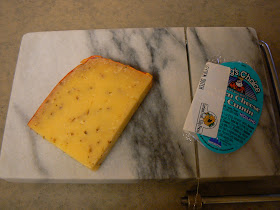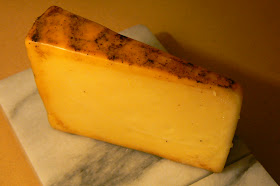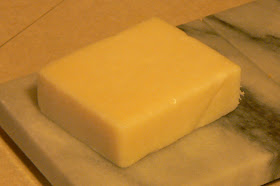Actually the "tronchon" shape is pretty traditional for certain parts of Spain, it just is extra stylized in today's offering.
It's always a bit of a treat when you come across a cheese listed in neither Murray's Cheese Handbook, published by the same folks responsible for the top-rate cheese counter in NYC, nor the even more comprehensive Cheese Primer by Steven Jenkins; truly one of the Dons of the US cheese crime scene. And by Don I mean the man is the first American to be awarded France's prestigious Chevalier du Taste-Fromage. Pretty much cheese knighthood. By US cheese crime scene I mean anyone who's anyone in US cheese. Yes there's a cheese A-list. He's on it, I'm not. Yet.
The point of this indulgence of my wandering mind is to point out that just because a cheese isn't explicitly mentioned by cheese royalty doesn't mean it's not worth trying. Case in point: Abrigo. A Spanish cheese that looks wild and has a dark and mysterious flavor, it further shows off what you can do with a little goat's milk and a lot of hard work. And salt.
Origin: Valencia, Spain
Milk: Goat, pasteurized
Rennet: Animal
Affinage: 3-5 months
Notes: Abrigo is Spanish for overcoat, or shelter. The shape doesn't scream coat to me, perhaps the mold covering the outside? Mine's a little on the elderly side so that mold has mostly dried and hardened into a shell but who can say. Must add "ask a Spaniard why" to my to-do list.
Thoughts: The milk of the proud Murciana breed of goats is used and the result is intriguing and horizon-expanding, if not a fast-favorite. The initial flavor is very muted, neither bold nor particularly tangy. As the flavor develops in your mouth, however, salty and tangy develop at the same time but remain mild. A very dry cheese with a slightly bitter aftertaste, Abrigo is reserved and some might even say underflavored, suffering from a lack of creaminess to better convey the muted flavors. Nevertheless the complexity and almost dark tone keeps it interesting and off the boring list. Besides, how could a cheese that shape be boring? I want to build a house around it. Caution
There is no to-do list. There is, however, a cheeses-yet-to-be-tried list, and it keeps me pretty busy as it is.






















